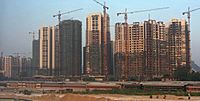
Photo from wikipedia
Abstract The rapid development of urbanization has had a dramatic impact on the ecological environment in China. In this paper, we first measure the urban eco-efficiency of 281 prefecture-level cities… Click to show full abstract
Abstract The rapid development of urbanization has had a dramatic impact on the ecological environment in China. In this paper, we first measure the urban eco-efficiency of 281 prefecture-level cities in China during 2006–2013 using the super-efficiency data envelopment analysis (SEDEA) model. We then propose a new comprehensive index system to assess urbanization. Finally, we quantitatively explore the relationship between urbanization and urban eco-efficiency based on a spatial econometric analysis. The results showed that China's average urban eco-efficiency and comprehensive level of urbanization of 281 prefecture-level cities had shown increase during 2006–2013. However, distinct spatial disparities exist among different cities. China's urbanization has significant characteristics of spatial agglomeration and spatial convergence during 2006–2013, with a high-to-low spatial distribution from eastern China to western China. Spatial effects play an important role in the changes of urban eco-efficiency in China through spatial spillover effects and regional replication and competition. Evidence from spatial econometric analysis reveals that an N-shaped relationship exists between urbanization and urban eco-efficiency, indicating that with the improvement of urbanization, urban eco-efficiency first increases, then declines and then increases again. The improvement of the level of technology and the formulation of effective environmental policies will promote the increase in urban eco-efficiency. The results provide significant references for urban ecological management and sustainable urban transformation in China.
Journal Title: Journal of Cleaner Production
Year Published: 2017
Link to full text (if available)
Share on Social Media: Sign Up to like & get
recommendations!